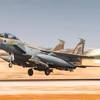Shipbuilding in a Box?
The twin screw anchor handling supply vessel Team Salalah has recently been delivered to its owners. The lead vessel of a series of six, it is the first vessel in the NICO fleet, custom designed for operations in both the extremes of the Persian Gulf and worldwide trading.
Team Salalah measures 61 x 15.2 x 5.5 m, and is a standard supply vessel layout: 350-sq.-m. sheathed working deck area aft; liquid mud and cement tanks arranged amidships and fuel oil; drill water and fresh water tanks distributed throughout the vessel's length. A 120-ton double drum tow winch is located immediately aft of the accommodation for anchor handling operations. The vessel is equipped to FiFi Class 1 requirement, and accommodation is arranged for a crew of 24 and features a hospital accessible from the open deck.
In addition to the normal list of owner's requirements, KMM were advised that the vessel was to be built at NICO's shipbuilding arm of Adyard, situated in Abu Dhabi, U.A.E. This is an existing repair and pressure tank fabrication facility with essentially no traditional shipyard equipment for new construction. It was thus decided that the vessel be constructed in kit form with KMM extending their normal design services to supply production level detail drawings.
The main hull structural components were cut and formed by Centraalstaal of Groningen, Netherlands in accordance with KMM's detailed design and lofting drawings. The vessel's hull features a deliberate attempt to simplify construction by eliminating all double curvature plating. Centraalstaal delivered the flat and formed components for each of the hull units by container. The unit breakdown was thus specifically tailored to suit the maximum internal dimension of the shipping containers. The deckhouse was fabricated and outfitted in advance of the main hull by Adyard itself.
KMM provided production level drawings for all outfit, mechanical and electrical systems using 3-D Cad modeling software to ensure proper utilization of space and to prevent interferences between systems. Piping systems were extracted in iso-metric spool drawing format complete with bills of material for fabrication at site.
The "kit-build" method of construction has allowed NICO to construct these vessels within their own limited facility making use of their ship repair and Oil industry personnel who have limited new construction experience. NICO procured all machinery and equipment in accordance with technical specifications and evaluation supplied by KMM. A Wärtsilä NSD integrated propulsion system comprising two of 8L26 engines each delivering 2,600 kW through Volda ACG 600H gearboxes to a Propac CPP system drives 2.95 m propellers in fixed 19A nozzles. Wärtsilä also supplied the 430 kW Brunvoll bow and stern thrusters. The propulsion and ancillary alarm and monitoring system was supplied by CSI of Holland and coordinated through Wärtsilä. The vessel is classified FiFi 1 with 1,200-cu.-m./hr. fire monitor pumps driven off each gearbox with the deluge system supplied from Wormald. Auxiliary power was also from Wärtsilä and is provided by two Cummins NTA855-G2M diesels gensets with 284Kw generators and a Cummins model 6CTA8.3G emergency genset with 160 kW generator. The ship's switchboard and MCC's were supplied by CMR of Singapore. The steering gear system is Jastram model S2-80-1-45.
The deck equipment package was supplied by Plimsoll of Singapore and consists of a 120 ton double drum tow winch, two 10 ton tugger winches, tow pins, shark jaw, combined anchor windlass and nylon rope storage winch and two five-ton capstans. The vessel was launched in January, 2000 and underwent extensive sea trials in the Arabian Gulf prior to being accepted by the owners and chartered in March of this year.
The kit concept is seen by KMM as particularly attractive, particularly to shipyards of limited manpower, technical capacity and equipment resources. The concept allows them to compete by providing the basic building elements in an accurate and complete package with full technical backup in support of their construction effort. This in turn provides owners with increased options when soliciting bids for vessel construction on the international market.










